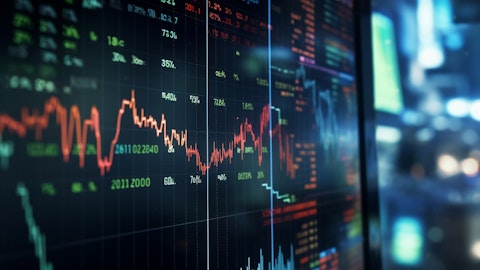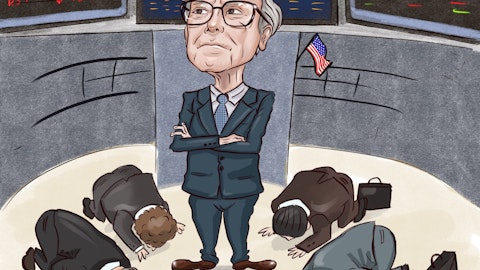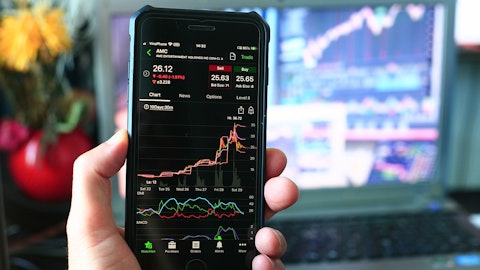Rob Lin: Next question?
Operator: Your next question comes from Alex Yao with JPMorgan. Please go ahead.
Alex Yao: I have a couple of questions on the value return to shareholder initiatives. So first of all, you guys currently have $35.3 billion available in the buyback program, which averaged roughly $12 billion per fiscal year compared to the 2023 calendar year buyback pace, this is a sizable step-up. Do you guys have the real serious intention to step up the buyback or put another way, how do you determine the $12 billion buyback per year is the right number to think about? And then holistically, if we add the buyback and dividend together and call it a yield to shareholders, do you have a target yield for the next couple of years?
Toby Xu: Okay. Thank you, Alex, for this question. I think the short version answer is, yes, we are serious. Of course, if you look at back of our track record, we have been — in the past few years, we have done a few upsizes of the share buyback program. So if you look at the sort of like track record, we’re actually if you like, sort of like exceeded the original timetable, if you like. So that’s why, we — the Board approved another upsize this time. So that’s why, as I said, we are serious. So in terms of how we decide this number, of course, we need to take a few factors into consideration, including our cash-generating capability and also how much cash we do — we will be able to sort of like generate to get it to offshore.
So all these we consider. And of course, as I said previously, the leveraging capability we have. So together, I think we consider a $12 billion is the right number — around the right number for us to do the buyback. So in addition to the buyback, for this upsize, the $25 billion, that’s only for the buyback. As we announced in the last quarter, we started to pay an annual dividend. So if you like, for the fiscal year ’23, including the buyback of $9.8 billion and the $2.5 billion dividend, actually, we’re giving back more than $12 billion back to the shareholders. And going forward, we are expecting continued with our cash-generating capability, continue to deliver — to give back the shareholders the cash as we sort of like committed.
Eddie Wu: Yes, I’d just like to supplement what Toby said, I’ll do a little bit of math on this question. Toby has said in his prepared remarks that we are targeting a 3 percentage points per year of accretion per year over the next three years through our buyback program. And that commitment is pretty real because if you look at the past 12 months, we actually reduced our share count by 3.3%. So that accretion is — we believe, is achievable. And if you look at our share count, we have about 2.5 billion shares outstanding and 3% is 75 million shares. If we are deploying $12 billion a year to buy back our stock at the current stock price, we actually would be able to buy back even more, but of course, we’re anticipating that our stock will increase in price over the last three years — over the next three years so that we can we could still keep it — keep our target of 3% accretion per year.
So, using the $12 billion a year of buyback with rising stock price, I think it is still reasonable to get to 3% accretion a year. So that’s math number one. Math number two is 3% accretion a year plus a dividend of $1 per ADS. The dividend yield is about 1.4% and so combined with the buyback, accretion and the dividend yield, you’re looking at about 4.4%, 4.5% which is actually quite close to the 10-year treasury yield. So if you buy Alibaba stock, it’s like you bought a 10-year treasury bond with the upside of stock price appreciation. So that’s the math we’re looking at.
Rob Lin: Next question.
Operator: Your next question comes from Gary Yu with Morgan Stanley. Please go ahead.
Gary Yu: I have a question for Jiang Fan on international business. Just wanted to see if there is any kind of particular market that we are focusing on and specifically, I want to ask about our strategy in the U.S. regarding fourth quarter e-commerce business, given the geographical rates ahead of elections. And we also talked about potentially stepping up the investment on the international business. How should we look at the level of segment loss in a couple of quarters? And how we’re going to fund the investment a bit more individual financing at the AIDC level? Or are we going to tap into more of the kind of offshore financing capabilities at the group level.
Jiang Fan: Gary, your background is quite noisy. Can you repeat your questions?
Gary Yu: Hi. Can you hear me better?
Jiang Fan: Yes, please go ahead.
Gary Yu: Okay. Apologies for that. I’m in the middle of a Chinese New Year dinner. So my question regarding international business and first one is any particular focus in terms of markets for the next couple of quarters. And specifically, what is our strategy in the U.S. market given the geopolitical risk ahead of elections? And the second question also on International is we talk about stepping up the investment. How should we look at the segment loss in the coming quarters? And how are we going to fund the investment between individual financing at the AIDC level versus tapping into the group — offshore financing at the group level.
Jiang Fan: So this is Jiang Fan, and I’ll take the first part of your question. We can break this out and look at the business in terms of cross-border versus local. So in terms of the local business, over the past several quarters, we’ve seen very rapid improvement in efficiency and rapid narrowing of losses, and we expect that to continue. The cross-border business, of course, addresses all markets everywhere. It’s a generic business model. And so in determining how we will allocate investments going forward, basically, we look at return on investment. We look at the efficiency of the investments we’ve made to plan our future investments. In terms of the U.S., we actually do have a business foundation there in 2C and 2B on alibaba.com.





